Vision Statement
At Hethersett Woodside, our aim is to develop confident and independent readers and writers.
We create meaningful experiences and drama activities which inspire the children to write. Writing is taught and celebrated daily across a range of subjects. We implement a knowledge-engaged curriculum, and through this we provide cross-curricular writing opportunities. Children are taught to consider the purpose, form and audience of their writing across a range of different genres.
The daily teaching of phonics in the Early Years and KS1 is supported by the Read Write Inc scheme, where the children learn the phonics sounds forming the foundations of early reading and writing. The Ruth Miskin Reading Scheme sits alongside this, with a carefully sequenced progression of knowledge and skills which children need in order to become fluent readers.
English lessons are taught using high-quality texts, supported by the Talk 4 Writing scheme. Younger children follow a carefully structured approach, building upon a rich story language. The children learn actions to help them remember the texts and their own stories are written with these scaffolds in place.
In Key Stage Two, children follow a similar process, with a quality text at the core of the learning but a variety of rich and relevant writing opportunities stem from the reading of longer novels.
Spelling, grammar and punctuation are taught as an integral part of each genre giving the learning a meaningful context.
Children learn reading skills through regular individual and focussed guided reading sessions. Teachers model reading practice during shared reading and provide opportunities for reading across the curriculum. We teach comprehension and discussion skills as an integral part of reading.
Writing
RATIONALE
The process of learning to write is complex; it involves a variety of skills but is an extremely powerful medium. Children need to learn to write dependent on audience, purpose and genre in order to communicate effectively. We aim for our students to be engaged, passionate and motivated with the writing purpose and so that they develop the skills that will be needed to continue their educational journey into high school and beyond.
TEACHING AND LEARNING
Within each year group, writing opportunities are primarily linked to 6 core texts, with 1 text being studied per half term. Each text has been chosen to allow children to experience a range of text types, so by the end of their primary journey they will have experienced a rich knowledge of authors and books. Choices for core texts have been made with consideration of a range of voices to further their understanding of the world, the curriculum and to broaden their horizon with regard to reading for pleasure. As a school, as we learn about new texts, or new texts become available, our selection of core texts may change.
The core texts to be studied by each year group are as follows:
Reception

Year 1

Year 2

Year 3
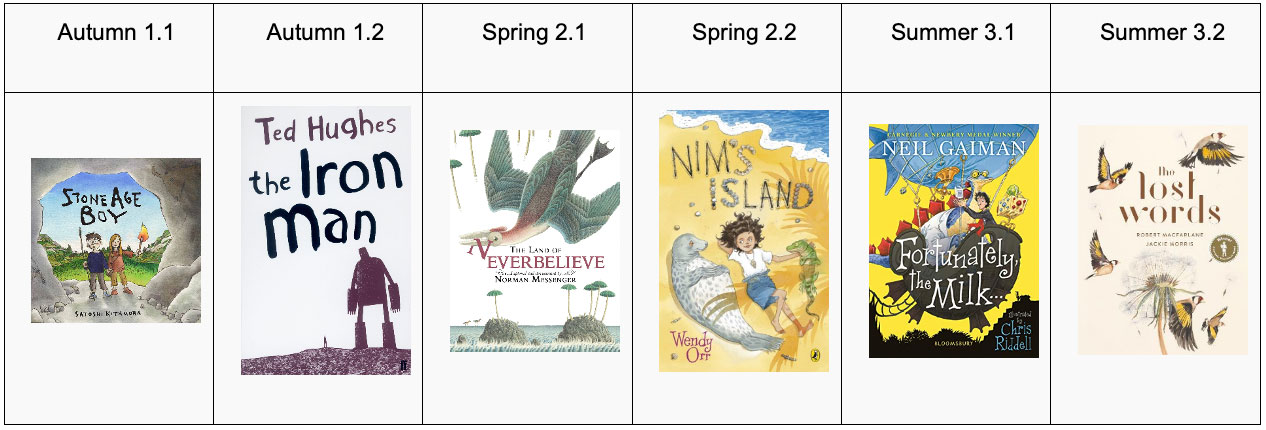
Year 4
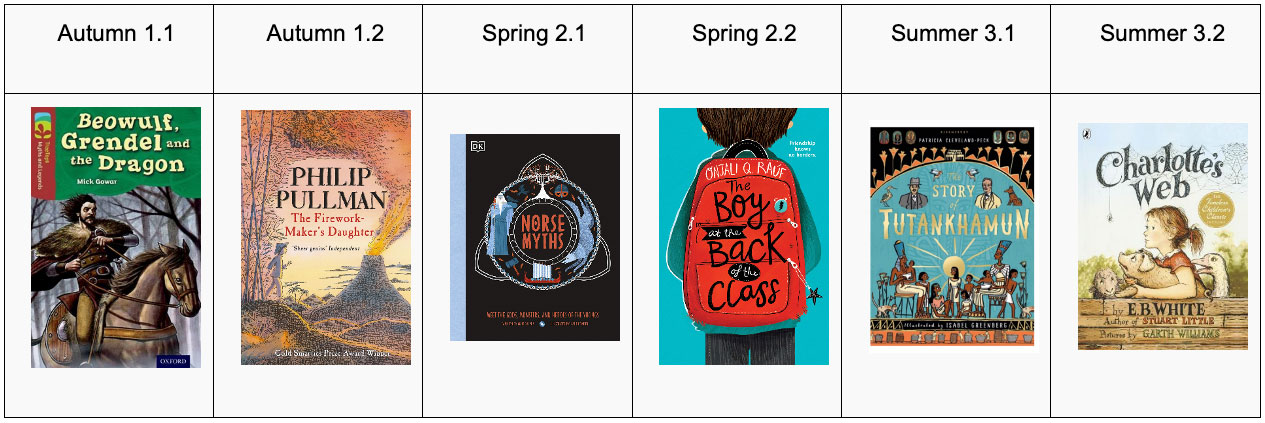
Year 5
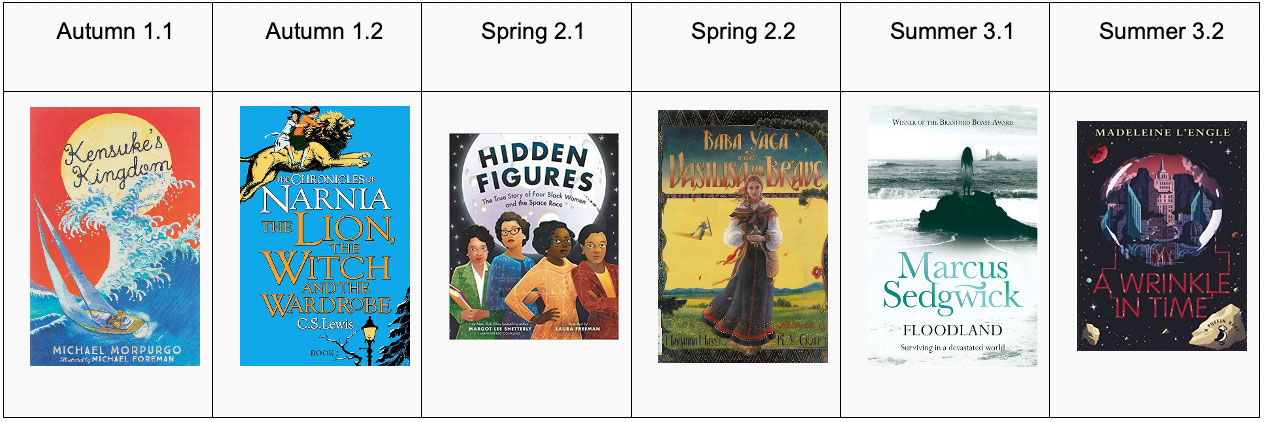
Year 6
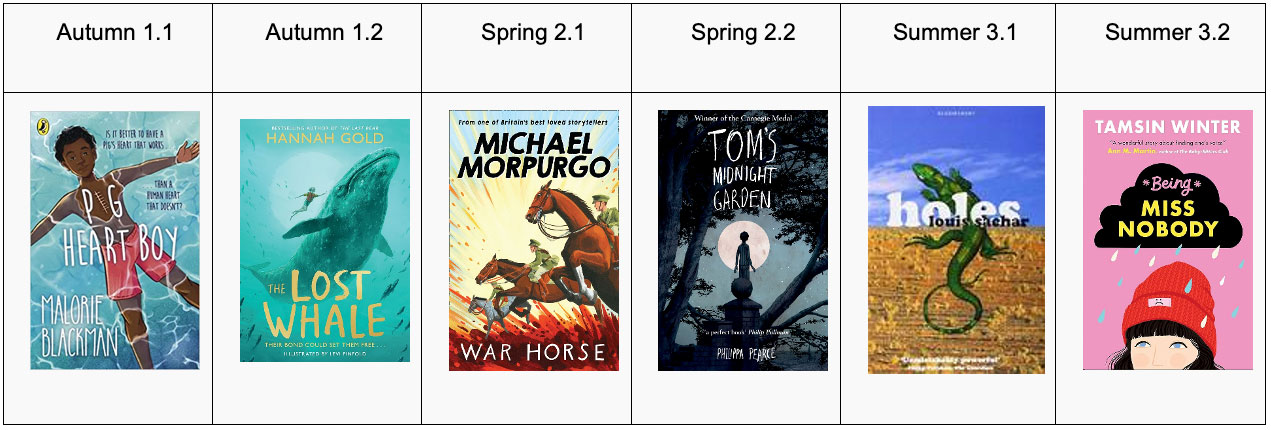
Sequences of learning are produced with the text type ‘end point’ in mind at the start of the planning process. There are a range of different text types that children will study to understand their features and how they can effectively write their own versions. Text type coverage has been mapped out across the school to ensure there is a balanced range of fiction and non-fiction opportunities, ensuring specific text types are revisited across year groups to demonstrate skill progression. Within this, opportunities to write in role are essential so that children are able to move out of their personal language register and to delve into other areas of language and vocabulary.
To begin sequences, children should explore examples of the text types they are focussing on so that they are familiar with the genre and stylistic features expected within their own work. Children should be made aware of how writers utilise technical elements alongside authorial intent to create an impact on the reader. Grammar skills and techniques should be taught explicitly within sequences of learning, to ensure that children are producing text types at an age-appropriate level building on prior learning and enabling them to be ready for their next step in their academic journey.
Within sequences of learning, children should have the opportunity to plan their extended written outcomes, as well as having specific editing and improvement time for their work. Writing should also be modelled by staff using a ‘think aloud’ process in order to make the process visible to learners.
INCLUSION
Technology should be used to support children where necessary so that barriers to producing extended written outcomes are removed and can allow the children to be independent and successful in their work.
Reading
RATIONALE
Reading is a vital life skill that every child has the right to develop; it is essential that children learn to read well in order to access all areas of the curriculum. Children must develop a love for reading in order to be motivated to develop their reading skills to ensure fluency and strong comprehension. Children should engage with a wide range of styles, genres and themes in different texts across their time in school in order to understand more about the wider world around them and to broaden their horizons. Ultimately, if a child cannot learn to read, they cannot read to learn.
TEACHING AND LEARNING
Reading skills and strategies are taught explicitly, throughout school. In the Early Years and KS1, children are taught to decode using the Read, Write, Inc. phonics scheme. Following this, children are taught in whole class guided reading sessions according to the Destination Reader approach.

Read, Write, Inc.
In EYFS, children are systematically introduced to letter sound correspondences with daily sessions, following the RWI scheme. Children begin to be grouped into Read, Write Inc. groups during Reception so learners’ needs are responded to.
Across Year 1 and 2, children are grouped homogeneously, according to their reading fluency. Reading fluency involves a number of key elements: accuracy (reading the words correctly), rate (not reading too quickly or too slowly), expression and awareness of punctuation. Children are regularly assessed to ensure they are working within the correct group to meet their needs and to respond to the progress being made; groups are purposefully fluid. Children are encouraged to read at home, using decodable books which match their current reading fluency skills.
Destination Reader
Once children have reached the end of the grey or ‘comprehension’ phrase in the RWI reading scheme, they move onto lessons focused on the specific skills and strategies detailed within the ‘Destination Reader’ approach. Children continue to build on these skills throughout their time in KS2 where classes have 4 timetabled sessions per week. The skills include:
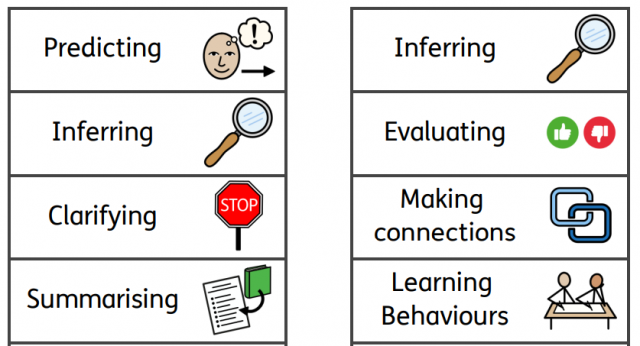
Sessions are also underpinned by focussing on learning behaviours, where they think about how to support and actively listen to others and how to discuss and explain their ideas using the non-verbal signals for ‘agree’, ‘build’ and ‘challenge’. Children demonstrate their comprehension of different text types by routinely completing ‘selfies’ and ‘bigger picture’ comprehension tasks. Texts are chosen in response to the needs of the learners; texts must be of a high-quality and support learning across the curriculum, whilst also broadening horizons.
READING FOR PLEASURE
Each class has a weekly school library slot to ensure they are selecting books based on their own interests and preferences and to ensure they read for enjoyment. All year groups also visit the local library.
To promote reading for pleasure and to allow for children to engage with books in a wide range of styles, genres, themes and voices, children participate in our ‘Reading Marathon. Each year, children are set the challenge of reading 26 books from an age-appropriate compiled list. Children will read 6 core texts within English lessons, alongside 4 non-fiction texts, 10 fiction texts and 6 independent choices to make up the 26 ‘miles’. For each book completed, children produce a piece of work to celebrate or represent that particular ‘mile’ in their journey.
After 26 miles, children are awarded a certificate in our celebration assembly, as well as receiving a token to select their book prize from our Reading Marathon vending machine to honour their fantastic achievement!
INCLUSION
Those children who have not secured their phonemic knowledge by the end of KS1 will continue to access the Read, Write Inc. programme and receive additional targeted intervention to ensure they catch up with their peers. Children’s reading development is tracked forensically throughout KS1 to ensure extra support is provided swiftly and effectively to ensure children keep up with their peers. To support children with developing their reading fluency, PiXL resources are used. For comprehension development, Grammarsaurus resources are utilised in a timely manner.
Handwriting
RATIONALE
The skill of handwriting needs to be taught; it is not a natural skill that will grow and develop like speaking or walking. Children need to be taught to develop a neat, legible style of handwriting where letters are formed and joined correctly with automaticity and appropriate pace. This is achieved through the systematic process of teaching, modelling and practising.
TEACHING AND LEARNING
Handwriting is taught in discrete lessons in classes, groups or individually as appropriate and work is completed in English, or Read, Write Inc. books. Lessons follow a ‘teach, practise, apply’ cycle. Teachers are to supervise children as they practise. All staff must model correctly joined handwriting at all times and demonstrate the neat, legible joins expected (Appendix 1).
In EYFS, letter formations are taught in conjunction with GPC learning. In Y1-6, letter formations or specific joins are taught explicitly. Children will have the opportunity to rehearse and reinforce these skills daily.
EYFS children should:
- Be given opportunities to develop arm muscles
- Take part in activities to develop gross motor skills, such as: air-writing, pattern making and dancing
- Complete exercises to develop fine motor skills, such as: mark making on paper, whiteboards, blackboards, sand trays and iPads
- Learn the letter shapes and formations taught by Read, Write Inc. set one sounds (as detailed in Appendix 2). There are four types of letters:
| ‘Around’ letters | c a o d g q |
| ‘Down’ letters | l t b p k h i j m n r u y |
| ‘Curly’ letters | e f s |
| ‘Zig-zag’ letters | v w z x |
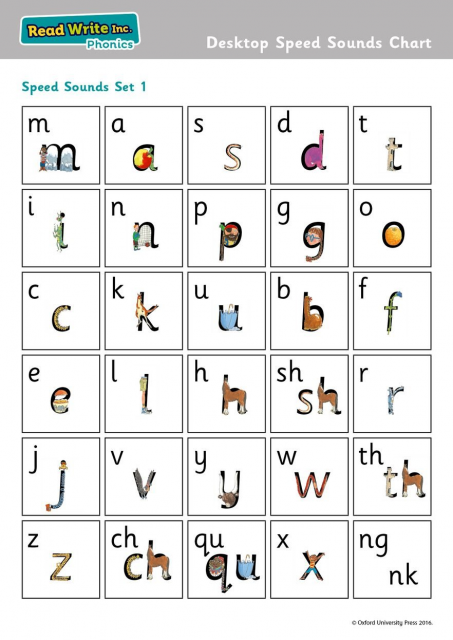
Year 1 children should:
- Sit correctly at a table, holding a pencil comfortably and correctly
- Be taught letter formation in the Read, Write Inc. set one sound order so that they understand which letters are formed in similar ways and to practise these, as detailed in Appendix 2. (Further details for how the grouped letter formation should be taught can be found in the Read Write Inc. Handwriting Stage 1b document.)

- Form lower-case letters in the correct direction, starting and finishing in the right place
- Use finger spaces between words accurately
- Form capital letters accurately
- Form digits 0-9 correctly in formation and orientation
Year 2 children should:
- Form lower-case letters of the correct size relative to one another.
- Start using some of the diagonal and horizontal strokes needed to join letters and understand which letters, when adjacent to one another, are best left not joined. We teach the Read Write Inc. letter joins, of which there are two basic joins: the arm join (diagonal) and the washing line join (horizontal). Each join has three variations.
- Arm to boat joins to small letters
- Arm to sun joins to tall letters
- Arm to sister letters
- Washing line to boat joins to small letters
- Washing line to sun joins to tall letters
- Washing line joins to sister letters



(Further information on each of these joins, staff should consult the Read Write Inc. Handwriting Stage 3 document.)
- Write capital letters and digits of the correct size, orientation and relationship to one another and to lower case letters
- Use spacing between words that reflect the size of the letters
Year 3 & 4 children should:
- Be revisiting, practising and developing the range of skills introduced in Year 2, allowing them to use the diagonal and horizontal strokes that are needed to join letters appropriately. All documents and guidance for handwriting joins can be found on the Read Write Inc. Phonics section of the Oxford Owl website.
- Increase the legibility, consistency and quality of their handwriting.
Y5 & 6 children should:
- Develop handwriting of a competent quality. This will involve the use of diagonal and horizontal strokes to join letters and understand which letters, when adjacent to one another, are best left not joined. Letters should also be consistently sized with equal word spacing.
- Have handwriting that is of sufficient speed to allow for the focus of writing to be on the content, not the presentation.
- Have developed stamina for writing, meaning they have the strength and mobility to be able to write for longer periods of time.
HANDWRITING POSITION
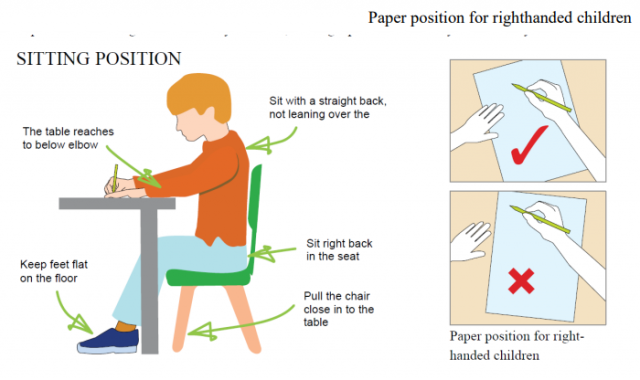
CORRECT PENCIL GRIP
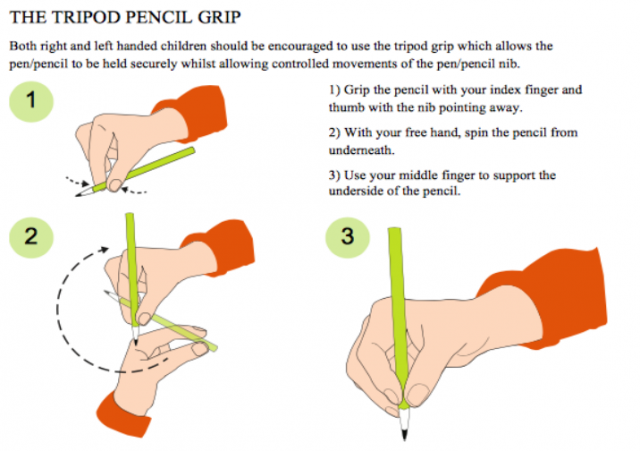
PROVISION FOR LEFT-HANDED CHILDREN
Left-handed children should sit on the left side of right-handed children, so that they are not competing for space. They are encouraged to find a comfortable orientation for their paper, usually slightly to the left of centre of their body. Teachers should be aware that it can be difficult for left-handed pupils to follow handwriting movements when they are modelled by a right-handed teacher and should accommodate demonstrations for left-handed students where necessary.
INCLUSION
Children with special educational needs will be supported through appropriate intervention. Use of the ‘Write from the Start’ programme should be used to support the development of hand-eye coordination, form constancy, spatial organisation and orientation skills.
APPENDIX 1


APPENDIX 2
EYFS Example Letter Formation Lesson Plan:





Spelling
RATIONALE
Proficiency in spelling is essential to allow children to communicate their understanding in all curriculum areas sufficiently; the process of learning to spell is cumulative and improves throughout our lives with lots of practice. In order for children to develop into effective and confident writers, they need to be taught a range of spelling rules and have an array of effective strategies to spell unfamiliar words. This is achieved through the systematic process of teaching, modelling and practising.
TEACHING AND LEARNING
Spelling is taught across the school using the Read, Write Inc. phonics and spelling schemes. The spelling programme builds upon teaching strategies and spelling activities that the children are familiar with from their phonics learning, ensuring skills are built on appropriately and cohesively.
EYFS – Y2 teachers should:
- Follow the Read, Write Inc. systematic phonics scheme daily to ensure children are understanding the link between blending for reading and segmenting for spelling and handwriting.
- Teach children to have an understanding of words that can be sounded out and words which are ‘red’ words, including the common exception words and some high frequency words with unusual spellings.
- Provide regular feedback, across all curriculum areas, to individuals and classes as a whole to draw attention to specific errors and misconceptions and ensure these are rectified.
Y2 – Y6 teachers should:
- Follow the Read, Write Inc. Oxford Owl spelling scheme, with 2-3 spelling sessions a week, where children are taught, have time to practise and consolidate their understanding of age-appropriate spelling rules. Understanding of spelling rules is developed through a ‘little and often’ approach.
- Check work after spelling sessions to ensure children are learning the spelling rules correctly. Practice does not necessarily make perfect; practice makes permanent and errors in spellings must be picked up swiftly to avoid mistakes becoming embedded.
- Teach children in KS2 to use dictionaries to check spellings, and meanings of words, independently.
- Introduce Y3/4 and Y5/6 word lists and provide learning opportunities for children to become secure in their use of these words.
- Provide regular feedback, across all curriculum areas, to individuals and classes as a whole to draw attention to specific errors and misconceptions and ensure these are rectified.
INCLUSION
Children with special educational needs will be supported through appropriate intervention. Read, Write Inc. sounds charts are displayed in all EYFS and KS1 classes as standard, with sounds charts provided for any students who require them within KS2. Similarly, KS2 classrooms all contain the Read, Write Inc. spelling charts. Hethersett Woodside utilises ‘Nessy’ to allow children to follow their own, personalised learning path when learning to spell. The program focuses on 8 essential components: phoneme-grapheme correspondences; six syllable types; suffixes; rhyming skills; phoneme identity, blending and segmentation; phonological awareness; phonic and word recognition and vocabulary; fluency and comprehension.
Progression Map
Woodside Core Texts
Achievements
Positivity Post
During the later half of the 2022/23 academic year, the school launched a project to focus on handwriting and presentation skills. As a school, we also wanted to do something nice for the local community! We decided to deliver some ‘Positivity Post’ to different houses around the school with the opportunity to use our best handwriting.
Examples of Positivity Post letters written by Y6 that were on display on their classes’ ‘Wall of Fame’.
In return, we asked for recipients to send us an email to help spread the kindness! We were blown away by the responses we received! Here are a selection of wonderful emails from members of the local community:
“Hello everyone in Year 3 and your teacher,
We came back on Monday from our holiday to find a big brown envelope beautifully decorated. At first we thought it was from our 8 year old grandson but then we noticed there was no address. We opened it to find a poem about adders. The person who wrote it had worked hard with their writing. I particularly liked the loops on y and g. There was a funny picture of an adder wearing a top hat. It made us laugh. My grandson saw an adder in the sand dunes at Sea Palling beach. He didn’t try to touch it because he knew it could bite.
Thank you so much for our lovely surprise poem. It made our day special.”
“Dear Hethersett Woodside Primary Children,
Thank you so much for the delightful positivity post I received yesterday through my letter box! It was a great surprise as it’s always nice to receive something new and exciting. I was very impressed with the handwriting and presentation of both the poem and envelope. It brought a smile to my families’ faces and to the Ukrainian refugees I have staying with me. So I thank you very much for your kind gesture.”
“Dear children at Hethersett Woodside Primary school,
Thank you so much for your positivity post which came through our door this afternoon.
It was lovely to receive such a friendly letter and very creative poem. The handwriting was excellent as were the pictures of our natural world. I understand you will all be having your summer term holidays very soon, which will be lovely to be outside enjoying the natural world, especially in this warm sunshine. Keep practising your handwriting, poems, and presentation skills, as your teachers and families will be very proud of you.”
“Good afternoon everyone …
Thanks very much for the poem which was posted through my letterbox today!
What a fantastic idea! I loved the poem about an adder – a beautiful creature that I saw once in Thetford forest whilst out on a bike ride. They are stunning …
Special thanks to the writer … beautiful joined handwriting and some lovely description! ‘Eyes like diamonds’ for example! Super! I used to teach Year 6 at the other school in Hethersett and was always frustrated that we couldn’t write more poetry – it’s fun and very creative with far less rules. Hope you have all enjoyed working on your poems. You maybe need to mount an exhibition of it! Keep working hard with all your writing because it is a wonderful skill to have that can bring great pleasure right through your life. You never stop learning! Many thanks again … keep working hard!”
“Good Morning, We hope you are well. We received a poem from you last week. We absolutely loved it and were very impressed with the dedication and effort put into it. Keep up the good work and we would love to see more of this in the future. A big thank you and well done to all the year 2 class at woodside, you have made Hethersett proud.”

